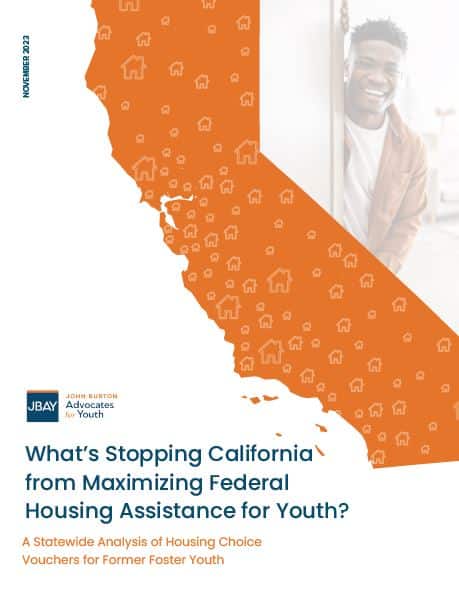Our Work – Housing
Supportive Housing for Foster Youth
JBAY helps transitioning foster youth achieve housing stability by expanding access to supportive housing.
JBAY’s work has focused primarily on expanding access to the Transitional Housing Placement for Non-Minor Dependents (THP-NMD), which serves youth participating in extended foster care, age 18 to 21; and the state’s Transitional Housing Program-Plus (THP-Plus), which serves youth after they transition out of care up to age 25. Both programs provide semi-independent housing and a wide range of supportive services, including case management, job training, educational support, and counseling. JBAY also works to increase access to federal housing vouchers for former foster youth. This work spans across both program access and improving policy.
Program Access
THP-NMD is a foster care placement licensed by the California Department of Social Services, and THP-Plus is a county-administered program. Both programs are most commonly operated by non-profit housing providers, or in some cases provided directly by county social services agencies.
Federal Housing Choice Vouchers for former foster youth are administered by the U.S. Department of Housing and Urban Development (HUD) to Public Housing Authorities (PHAs) through the Family Unification Program (FUP) and the Foster Youth to Independence (FYI) program. PHAs administer the vouchers locally and partner with their county child welfare agency which provides supportive services to youth with vouchers.
JBAY maintains rosters of all actively licensed and operating THP-NMD programs, all county-contracted THP-Plus programs, and all Public Housing Authorities throughout California, organized by county. JBAY also develops technical assistance publications for providers and county agencies.
Resources
Webinars
Policy
Since 2005, JBAY has worked at a state policy level to strengthen THP-Plus and maintain and improve access. Based on the success of THP-Plus in improving outcomes among youth when they are supported beyond age 18, JBAY advocated for the extension of foster care to age 21 which resulted in the passage of Assembly Bill 12 and the development of THP-NMD (2010). Below is a list of policies and budget investments led by JBAY to strengthen and improve access to these programs, in addition to housing vouchers for former foster youth:
- Protected THP-Plus from budget cuts during the Great Recession. (2009 & 2010)
- Created a state funding source that counties can use for their THP-Plus programs called the Transitional Housing Program, funded with $8 million. (2019)
- Created the THP-NMD Housing Supplement, providing additional funding for THP-NMD based on the cost of housing and a higher amount for parenting youth. (2020)
- Worked with a coalition to secure $32 million in state funding to allow youth turning 21 years old to remain in extended foster care, including THP-NMD, until June 30, 2021; and for a policy to allow youth to remain in THP-Plus regardless of age or program duration to protect youth during the COVID-19 pandemic. (2020)
- Made the Transitional Housing Program and Housing Navigation & Maintenance Program (HNMP) permanent. (2021)
- Established the $9 million THP-Plus Housing Supplement, providing additional funding for THP-Plus in counties with high rental costs. (2021)
- Increased the THP-Plus program from 2 years to 3 years and changed the upper age limit so youth can access it until they turn 25 instead of 24. (2022)
- Expanded the Transitional Housing Program budget from $8 million to $33.3 million. (2022)
- Expanded the HNMP budget from $5 million to $13.7 million. (2022)
- Established designated services funding for former foster youth with FUP/FYI housing vouchers by expanding the priority population of HNMP and increasing the upper age limit. (2022)




